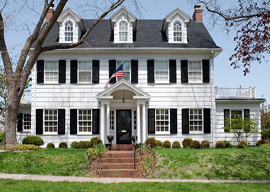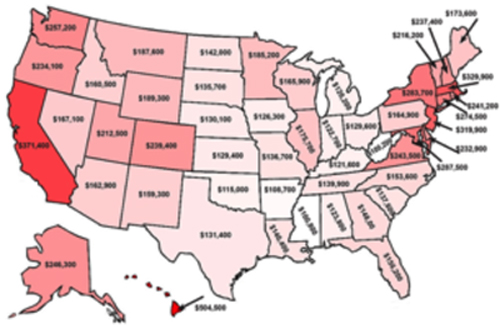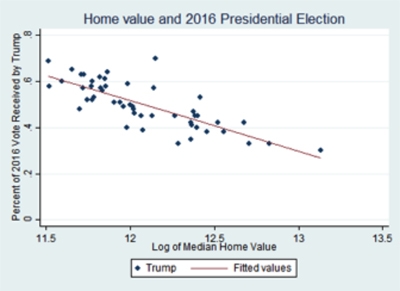
June 14, 2017

Source: Bigstock
The insightful blogger who goes by the moniker Spotted Toad has created a series of charts explaining the 2016 Electoral College results as a result of average home price in each state.
The pattern is much the same as it has been in every election since 2000: In states where younger white people can better afford to buy a home, they are more likely to be married, have more children, and vote more Republican. In states where whites are less able to afford a home, they marry later, have fewer children, and vote more Democratic.
For example, the state with the most expensive homes on average is Hawaii, at a self-estimated mean during 2010″14 of $505,400 (according to Census Bureau data). Not coincidentally, Donald Trump did worse in Hawaii than in any other state, garnering only 30.0 percent of the vote.

In contrast, in the state with the cheapest housing”West Virginia, with its mean home value of just $100,200″Trump enjoyed his biggest majority: 68.5 percent.
These aren”t fluke outliers, either.
Trump won the 22 states with the cheapest homes, and 26 of the 27 least costly states. Conversely, Hillary Clinton carried 15 of the 16 states with the most expensive housing. (The most expensive red state was No. 9 Alaska and the least expensive blue state was No. 28 New Mexico.)

Here is Spotted Toad’s graph showing the fifty states, with Trump’s share of the vote on the vertical axis and home values on the horizontal axis. The correlation coefficient for the relationship between Trump’s share of the vote and home values in each state was “0.76, a very strong negative correlation.
The next most expensive homes after Hawaii are in California at a mean of $371,000, where Trump won only 31.6 percent.
California had voted Republican in nine of ten presidential elections from 1952 through 1988, but has now gone Democrat in the past seven elections, beginning with 1992.
This reversal is usually blamed by the media on Republican governor Pete Wilson coming from behind in his 1994 reelection bid by endorsing the popular immigration restrictionist Proposition 187. And this explanation that the California GOP was done in by the subsequent anti-187 anger of the Latino electoral tsunami is widely assumed to be true by GOP “strategists” too dumb to notice that 1994 followed, rather than preceded, the turning-point election of 1992 when George H.W. Bush lost California to Bill Clinton by a historic 13.4 percentage points.
In reality, the bigger problem dooming the California GOP was that it stopped routinely carrying white voters by comfortable margins. And this shift was likely related to the massive surge in California home prices. The state’s homes were no more expensive than the national average until 1975, but have since become increasingly expensive as California homeowners have figured out how to manipulate environmental regulations to slow the construction of new homes and roads.
Growing up in the San Fernando Valley of Los Angeles, I had a front-row seat since the watershed year of 1969 to watch the celebrities of Beverly Hills, Santa Monica, and Malibu learn how to exploit environmentalism to drive up their property values and keep out deplorables from the Valley, such as me. (Simultaneously, the Westsiders denounced Americans who didn”t want to let in more illegal aliens as vicious racist xenophobes raising the wages they”d have to pay their servants.)
In a 2016 paper entitled “Residential Building Restrictions, Cost of Living, and Partisanship,” Dartmouth professor of government Jason Sorens asked:
Why have richer U.S. states become more Democratic and poorer states more Republican? I find that this phenomenon actually reflects cost of living, driven by residential building restrictions…. By making housing supply less responsive to price, land-use regulation increases house prices in locations that are highly desirable for either amenities or production.
For example, Malibu’s most famous amenity is 21 miles of beaches. But an even better amenity than a public beach is a de facto private beach, so Malibuites such as Rob Reiner have managed to keep its population below 13,000 by severely restricting housing development.
Malibu voters don”t even want you paying to vacation on their turf. By my count, Malibu has only 184 hotel or motel rooms. “Stay out of Malibu, Lebowski!” would make a truthful civic slogan.
Meanwhile, billionaire producer David Geffen waged a 24-year-long legal battle to ignore the state law mandating he provide public access to the beach in front of his house (which he recently sold for $85 million).